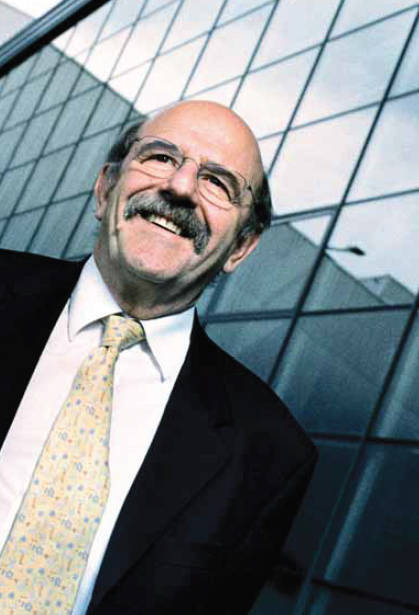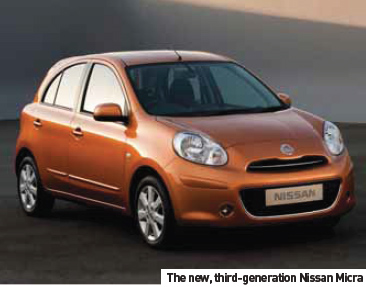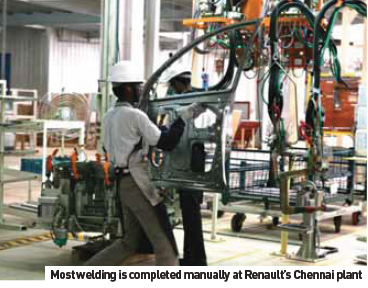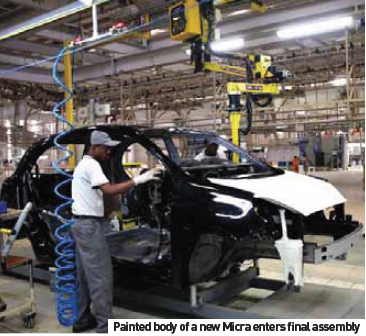 Michel Gornet, Executive Vice-President, Manufacturing and Logistics, talks about the Renault-Nissan Alliance´s new plant in Chennai, India and reviews the company’s global manufacturing activities.
Michel Gornet, Executive Vice-President, Manufacturing and Logistics, talks about the Renault-Nissan Alliance´s new plant in Chennai, India and reviews the company’s global manufacturing activities.
AMS: Why did you decide to build a factory in India? What are the advantages?
MG: India represents an important market for Nissan. India will be Nissan’s global hub for the export of compact cars. Also, Nissan is striving to produce vehicles closer to the market. Building the factory in India is our commitment to offer our product to the Indian market which will be the major auto market in near future.
AMS: And why did Nissan choose Chennai as the location for the plant?
MG: Chennai has a strong automotive industry base. Chennai also has advantages in regards to the export of parts and assembled vehicles due to Ennore and Chennai port.
AMS: How long has construction taken for the Chennai plant?
MG: The plant took 21 months to build.
AMS: Tell us about your view of the new plant in
Global sales in 2009CY - 3,368,014 units
Global sales in 2009FY (Forecast) - 3,480,000 units Number of countries with production sites: 18 Japan, USA, UK, Spain, India, Taiwan, China, Thailand, Philippine, Malaysia, Indonesia, Mexico, Brazil, Iran, South Africa, Kenya, Egypt, Pakistan
Number of plants: 28 (including Chennai)
Japan 4, China 3, USA 2, Spain 2, Philippines 2, Malaysia 2, Mexico 2, Indonesia 1, Brazil 1, Iran 1, South Africa 1, Kenya 1, Egypt 1, Pakistan 1, India 1, Taiwan 1, UK 1, Thailand 1
The Alliance partnership
The Renault-Nissan Alliance was formed 11 years ago. In the past, the Alliance was used to maximize the performance of each partner. Today, the economic environment and the situation of both Nissan and Renault have completely changed. Against this new backdrop, the companies say that the Alliance will be used as leverage to counter the crisis and prepare for the future.
Chennai, India – particularly the equipment choices?
MG: At Chennai, we have tried to install the standard (Renault-Nissan) alliance process, to seamlessly manufacture Nissan and Renault cars. You may recall that a few years ago we decided to build two plants, one in Tangier (Morocco) and the other in Chennai. Both were supposed to be alliance plants, producing both Renault and Nissan cars. Then we decided that Renault would run the Moroccan plant and Nissan the Indian plant. Then came the financial crisis and we decided that we did not need the capacity of two full plants; capacity at the Chennai investment is now smaller than first planned. The same applies to Tangier. Now Chennai is ready, with a capacity of 30 units per hour (uph), up to 400,000 units per annum (upa).
AMS: The plant operates under the distinct, separate manufacturing philosophies of both Renault and Nissan? MG: Not at all, it is a common process, we can make cars the same way whether they are Renault or Nissan plants. But this does not mean that we are going to merge the manufacturing organisations. The Chennai plant will be run by Nissan, but it will also manufacture cars to be sold by Renault. Our Nissan plants in South America produce Renault models and Nissan is producing LCVs in Barcelona (Spain) for Renault.
AMS: Is this similar to the General Motors Global Manufacturing System, where the best ideas from each partner are brought together in a single system?
MG: The problem is that we are not going to reshuffle all our existing plants. For new capacity, we made the clear decision to be able to make cars from and by each of the partners. To change (or update) existing plants would be impossible. In new plants like Chennai, it makes sense to build-in capacity and technology to enable use by both partners.
AMS: In Chennai you are starting off with the new Micra (production started in May this year), based on the new ´V´  platform. Next will be Koleos and Fluence?
platform. Next will be Koleos and Fluence?
MG: The new Micra will be the only car we build in Chennai this year. When the Koleos and Fluence are introduced, they will be built on an SKD basis. I don’t think they will go to full production, including stamping, unless there is a huge demand for these cars. Of course, we plan to introduce other cars to be fully manufactured in Chennai in the future. AMS: Do you have any plans to stop deliveries of Japanese made Teana and X-Trail models, shifting production to Chennai?
MG: We do not have any plans at this moment, but we are studying feasibility of this to optimize our production capacity.
AMS: Chennai is not the place to try revolutionary production technology, but are there some processes that you would consider ´cutting edge´?
Timeline
2008 February - Memorandum of Understanding (MoU) signed with state government of Tamil Nadu
2008 June - Ground-breaking ceremony
2008 December - Start of plant construction
2009 August - Equipment trials begin
2009 November - Trial production begins
2010 March - Inauguration of new Chennai plant
2010 May - Start of production
2010 July - SOS to India
2010 Aug - Start of production for export
2010 Sept - Start of exports
Total area and structures
Total land area: 2.6m m2
Total building area (5 shops): 300,000 m2 inc:
- Stamping shop
- Bodyshop
- Paint and plastic
- Trim and chassis
- Powertrain (Engine assembly)
Capital investment
Investment to date: Rs 28.8bn ($650m)
Total investment: Rs 45bn ($925m) in seven years from date of MoU (Feb 22, 2008)
Production capacity: 400,000 upa at full capacity
Production capacity (2010): More than 80,000 units (65,000 units for export)
Daily output (at start): 500 units per day, 30 units per hour
Shifts: 1 shift at start, moving to 2 shifts in late 2010
Employment
Start of production (May 2010): 1,500 employees
2012: 3,000 employees
Overseas trainees: 215 sent to Japan, UK, China and Russia for management and technical training
Model production and supply
- Next-generation Micra, to be followed by saloon model based on ´V´ platform
- Parts localization: 85% goal of local part production
- Six suppliers (maximum of 20) are located in plant supplier park:
- Lear Tacle (seats)
- Unipress India (body parts)
- Motherson Sumi System (wire, harness)
- Tenneco Exhaust India (exhaust)
- Tieter Nittoku India (floor carpet)
- POSCO (steel coil)
- Other suppliers: 97 suppliers in India. 50% located in Chennai area. A further 10% are in Pune, 10% in Bangalore and 30% in Delhi
Key equipment
Press shop (including blank cutting and pressing) features a 1,000-tonne press from Renault’s plant in Sandouville, France, and a 2,700-tonne press supplied by Rotem of Korea. Paintshop equipment is from Geico (Italy) and Taikisha (Japan).
Special features
AIMS (Alliance Integrated Manufacturing System)
- Producing Renault and Nissan vehicles
- Can operate with four different platform types
- Up to eight body types can be produced on same line
Regenerative Thermal Oxidizer (RTO) and environment
- Harmful VOCs discharged from painting process are converted into CO2, H2O and reusable heat. These byproducts are released into atmosphere through a specially-designed heat transfer and regenerator system
- The first system of its type to be introduced in India
- The system features at all Nissan plants worldwide
- 5% of complex roof is fi tted with transparent sheet, allowing natural light to illuminate the floor.
- 0% water discharge through water recycling and reuse
MG: We have tried to make the production system there as simple as possible, using a lot of manual processes to build in flexibility. We call this AIMS – the Alliance Integrated Manufacturing System – which means we can make many different platforms and bodies on these platforms with maximum flexibility; at the same time or for replacement vehicle lines. This is enabled by a clever jig-changing system, a little like what Nissan does in China, but further improved by taking the best of both companies. For example, for making all the closures, the AIMS way is to use roller hemming as this is much more flexible than clinching by presswork.
Timeline
Renault has 46,000 employees in Europe, including 700 managers working at the manufacturing departments in six car assembly plants, three in France, two in Spain and one in Slovenia and also eight powertrain plants, fi ve in France, two in Spain and one in Portugal.
 Manufacturing functions
Manufacturing functions
The body-assembly sector consists of four main activities - stamping, BIW assembly, paint and fi nal assembly, supported by three technical support functions: logistics, quality and maintenance (plus other functions, including human resources).
The Manufacturing Department also co-ordinates plant functions, manages progress plans and ensures industrial uniformity throughout Renault’s manufacturing sites, including those reporting to other divisions (LCVs) or located in other global regions (Brazil, Argentina, Chile, Turkey, Romania, etc.).
Reporting line
Basic Work Team leader: Manages teams of up to 20 employees. Shop foreman: In most cases, shop foremen are highly-experienced engineers or supervisors. Five years’ experience as a shop foreman can serve as an excellent gateway to engineering functions in process design.
Production department manager: Members of the engineering and managerial staff and production department managers are each entirely responsible for a specifi c car manufacturing technology and receive support from the shop foremen in their day-to-day duties.
Powertrain engineering
More than 5,000 people currently work in the Powertrain engineering department (DIM), including 1,000 staff working at production sites in France, Spain and Portugal.
There are three main skill groups in Powertrain engineering: powertrain product design, engines and gearboxes. These jobs involve the creation of new engines and gearboxes which fulfill performance and cost objectives while meeting technical standards for the environment. Half of DIM employees, approximately 2,000 staff, 40% of whom are engineers, work in this domain. Job profi les for powertrain designers include: engineers and technicians with general training in mechanical design, as well as specializations in combustion, fluid mechanics, thermodynamics, acoustics and tribology. For electronic control systems design: engineers and technicians specialized in electronics, automatic control, power assistance, computer science and measurement. Design and implementation of production facilities Employees in this area are charged with designing the production facilities for new engines and gearboxes by modifying production lines. Production facilities must meet quality and cost optimization objectives. Over 900 staff work in this area, most located on-site in active production plants (France, Spain, Portugal). Employee profi les include: powertrain production engineers and technicians specialized in robotics, control and logistics.
Test implementation
Prototype testing employs 600 people who contribute by making fi nal adjustments to new components. For this area, the DIM requires candidates to be technicians (Bac+2, Bac+3 or equivalent), with training in engines, gearboxes and physical measurement. In addition, the Powertrain engineering department reserves a certain number of positions for experienced engineers, either generalists, specialists or those with experience in project management.
The Powertrain engineering department also places emphasis on quality. This cross-functional activity aims to develop optimal work procedures for QCD (quality, cost and delivery times). Profi les sought are those of engineers and technicians specializing in quality analysis, assurance and statistics.
AMS: Who are your equipment partners for this process?
MG: The robots are from ABB and the tooling comes from a roller hemming expert partner.
AMS: The rapid and flexible jig-changing that you use, is this all hand-operated or are you using some servo power? MG: The changeover of the jigs is incorporated in the takt time. You can move from one type of vehicle to another on the line without removing tooling completely from the line, there are alternative tools on overhead carriers on the bodyin- white (BIW) line. And of course, the BIW line is almost all manual welding. We have just a couple of robots for the heavier weld operations in the main spot line.
AMS: Quality has been the big driver at Renault over the last few years – how are you going to maintain this in India?
MG: We are not making cars in a very different way than in other countries. We have the highest quality production way, which is a mix of the Renault way and the Nissan way. We make sure the people here are trained to reach these standards and that they can achieve them.
From a quality assurance point of view, we’ve introduced a welding counter for 100% of all weld points in the bodyshop and a torque checker for 100% of all fixing points in trim and chassis to guarantee the fundamental quality required for the Euro market.
bsenteeism or similar labour problems, you must ensure that you have at least three trained people trained in the process at that station and that each operator is able to work in three different stations. Each unit leader will have a chart where he is checking that for each line, he has three crosses on his chart and in each column he has three crosses – the line being the people and the column being the workstation. If he does not have this, he has to check the training programme and start some more people on the programme. We trained team leaders in Japan and also in Sunderland, UK, and those people became the trainers for the locallyhired line workers.
AMS: How can you ensure part quality, especially locallyproduced parts?
MG: Nissan has worked with our suppliers in India to improve the quality to the same standard of global quality which Nissan is setting.
AMS: How have you found the standard of the local workforce and are you mainly employing graduate-level educated people?
MG: We hired degree-level people for the management positions. For line workers, we looked for high-school graduates who have reading, writing and basic numeracy skills. What we´re really looking for is people who are ready to work in teams and learn our production way.
AMS: How much local management do you have in place now and how much more will be in place in the future?
MG: In the human resources and production management departments, we have Indian people in place now. The area managers, BIW, paintshop, assembly, etc., at present are Japanese, but they are training their Indian replacements for the future.
AMS: Can you see the upper-level management becoming Indian, as in Fiat at Pune with Rajeev Kapoor? MG: At present the president is Japanese, Mr Sakurai, and the plant manager is also Japanese, but below them the production manager is Indian. This fairly early adoption of local management is the usual Nissan way.
AMS: Is the plant design based on an existing Nissan facility somewhere else in the world?
MG: The stamping shop features a fully-automated transfer system, like our plants in the US, Europe and Japan. The bodyshop at Chennai features a 15% automation rate, which compares to 100% in the US, between 85 and 90% in Japan and 40% in China. The percentage of welding in India will increase, though, with increased volume and the number of models in production. In the paintshop, application of the exterior top coat is 100% automated, the same as other Nissan plants. In trim and chassis, automation is included in quality-related processes, such as filling, gluing and axle subassembly, and also for some checking and testing.
AMS: Looking at Renault-Nissan manufacturing globally, can you think of a ‘new’ technology that has been particularly successful in an emerging market plant situation?
MG: The only really new technology (new for us at Renault) that we have introduced at Chennai is the three-wet painting system. This is saving us a lot of energy; we have to dry the car only once of course, and it costs a little bit more to accommodate the flash-off time between the various coats, but since you have one less oven, it balances out. In Chennai we are not yet using water-borne coatings, it is still solvent borne paint, but we use incinerators to burn off the waste and capture the heat energy for the ovens.
In May 2008 Nissan announced three joint-ventures with Ashok Leyland for vehicle assembly, engine assembly and vehicle development.
With an investment of Rs23 billion ($575m), operations were due to start in 2011 or 2012, but due to the financial crisis, both companies have decided to review investment plans and review production optimisation for available capacity utilization. The companies are now studying production of NV200 LCV at the Chennai plant for both brands.
In a joint statement made last November, the companies said: “We confi rm that Nissan and AL have decided to optimize their JV investment and use available production facilities in the fi rst phase. They will now use Ashok Leyland facilities as well as the Renault- Nissan new plant in Chennai. The originally-proposed new facility will eventually be built in a greenfi eld site, which is being pursued.” Production of LCVs in India will start in mid-2011.
AMS: You recently announced a big investment at Valladolid engine plant, can you tell us more about this? MG: The engine will be an all-aluminium unit, block and head, which we have done in the past but currently we only make cast iron blocks. The development and engineering of this motor has been very exciting and has taken a lot of effort by the various teams.
AMS: And the electric vehicle programme?
MG: We are starting production of the Kangoo electric in the Maubeuge plant in northern France, with another electric car line in Bursa, Turkey, for the Fluence. These are really cars where we replace the IC engine with an electric powertrain, they were not designed as electric cars from the start. In Flins, however, we are preparing a totally electric car. This is very much in the early stages.
AMS: What about the impact of electric vehicles on the machine tool makers?
MG: Yes, there will be an impact as the machining operations are much fewer but we do not expect to make more than 10 or 15% electric for quite some time. We still have a lot of IC engines to make and we have to go on working to make those motors cleaner and more efficient.
AMS: You are quite late in launching a factory in India. Are you worried that this will affect your competitiveness?
MG: We are very serious and committed about our plans in India. We are very confident that the Indian customer will appreciate our product offerings. Launch of the factory in India will help to reinforce Nissan’s position by being able to shorten the period of delivery and being more flexible when reacting to the requirements of the customers.


































